We are currently in Christchurch and it is Christmas Day here. Everything is closed, except one “Email” shop on Cathedral Square, in the “City Centre”. We are doing well in spite of the rain, which came in overnight after a brilliant, sunshiny day yesterday, which we both really needed. Christmas Eve morning found us in Akaroa, a small town on Bank’s Peninsula, right outside of Christchurch. The night before, the wind howled and the rain blew horizontally down the streets while we searched in vain for a cheap place to eat.
An aside: While jet lag wasn’t a big deal on this trip for either of us, the change in the amount of daylight hours has proven to be a little challenging. When we left Memphis, we were used to a sunrise about 7:30 AM and a sunset before 5 PM. However, after landing here, with the change to the Southern Hemisphere so close to their summer solstice, we immediately began (joyfully) experiencing sunrises at around 5:30 AM and sunsets close to 9:30 PM, and the time with daylight actually increased as we moved south down the island. As a result, we found ourselves staying up late, usually after midnight, and then trying to rush to get out of the hostel and on the road by 10 AM the next morning. This also usually pushed back our arrival time in the next place we were going a few hours, which occasionally made the difference between getting to town in time to visit a grocery store (many of which strangely strictly close at 7 or 8 PM, right when a lot of people want to do their shopping) or digging some ramen noodles out of the tucker bag. Several times, we found ourselves in towns full of visitors and people out and about but absolutely no stores available in a 50 KM radius. You would think that one store would open, if only because they would get all of the business of all of the visitors in the town, but, nope, everything was closed.
We really aren’t complaining and we were able to deal with it; after all, this is one of those interesting little cultural things that you experience travelling. But in this world of SuperCenter Wal-Marts and 24-mega malls, you would think that convenience store that stays open to, say 11 PM instead of 8 PM, wouldn’t be that strange. However, in the rural areas here, that is as rare as hen’s teeth.
Christchurch has proven to be a very relaxing place after the hectic nature of Dunedin, which cannot be completely chalked up to pre-Christmas preparations. This place has a must more laid-back style to it, with a lovely stream called the Avon snaking through town and a very accessible botanical garden a few blocks from the very center of the city. The streets are very walkable, and the variety of food on offer is greater than anywhere else we’ve been in New Zealand. It could probably be said that it rivals New York, especially per capita. Malay-Indian fusion food, anyone?
We are having a very relaxed Christmas holiday, sleeping in and enjoying a breakfast cooked by our B & B hosts, Gerald and Pauline. Tomorrow we fly off to hectic Sydney for a week of catching up with our friends there, including taking in a trip out of town to Hawk’s Nest, near Newcastle.
We hope that all of you are with loved ones for the holiday season. Merry Christmas!
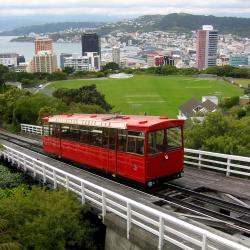 We spent our first day simply wandering around and catching some of the better museums. I can recommend to anyone that the first thing you should do in Wellington, so long as it is daytime, is to take the cable car to the top of hill that overlooks the city and then wander through the botanic gardens as you walk downhill back to the city. The part about downhill is very important. Downtown Wellington is shaped like a roughly-shaped bowl, open on the side that faces the harbor. As long as you stay near the water, you will not have to climb too many hills. However, leave the main downtown area and you will really give your legs (and lungs and heart) a work-out. After a couple of days, Kath and I have learned to ask questions of ourselves when planning a particular trek, such as: “How far up will this take us?” or “Is there a similar store that is not over that steep ridge?”
We spent our first day simply wandering around and catching some of the better museums. I can recommend to anyone that the first thing you should do in Wellington, so long as it is daytime, is to take the cable car to the top of hill that overlooks the city and then wander through the botanic gardens as you walk downhill back to the city. The part about downhill is very important. Downtown Wellington is shaped like a roughly-shaped bowl, open on the side that faces the harbor. As long as you stay near the water, you will not have to climb too many hills. However, leave the main downtown area and you will really give your legs (and lungs and heart) a work-out. After a couple of days, Kath and I have learned to ask questions of ourselves when planning a particular trek, such as: “How far up will this take us?” or “Is there a similar store that is not over that steep ridge?”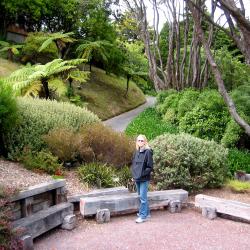 The museum that really got me excited about coming to Wellington was Te Papa, the new national museum opened only a few years ago. And, I can say that the museum really doesn’t disappoint, expecially since I mostly wanted to see exhibits concerning the experiences of the Maori people (the native inhabitants of New Zealand). I read several books regarding the inital impact of European culture on Maoris, and since most cultural sites revolving around Maori culture are located in the North Island, in places we weren’t going, I was keen to see what I could, especially if I could glimpse it in the mind’s eye of the “average” New Zealand citizen (or even want they wanted to project to the world). Te Papa does a great job of not only bringing Maori history and culture alive but also showcasing current and relevant Maori struggles in the perspective of the various participants, Maori and non-Maori alike. Te Papa is not scared to address issues that are not really settled yet and are still heavily contended. I learned a lot from the museum that I would have never picked up from books, and I guess that might as well be the definition of an important museum.
The museum that really got me excited about coming to Wellington was Te Papa, the new national museum opened only a few years ago. And, I can say that the museum really doesn’t disappoint, expecially since I mostly wanted to see exhibits concerning the experiences of the Maori people (the native inhabitants of New Zealand). I read several books regarding the inital impact of European culture on Maoris, and since most cultural sites revolving around Maori culture are located in the North Island, in places we weren’t going, I was keen to see what I could, especially if I could glimpse it in the mind’s eye of the “average” New Zealand citizen (or even want they wanted to project to the world). Te Papa does a great job of not only bringing Maori history and culture alive but also showcasing current and relevant Maori struggles in the perspective of the various participants, Maori and non-Maori alike. Te Papa is not scared to address issues that are not really settled yet and are still heavily contended. I learned a lot from the museum that I would have never picked up from books, and I guess that might as well be the definition of an important museum.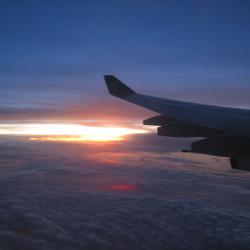 We made it to Wellington without incident, connecting through Tahiti and Auckland, as planned. Up to now, we had always flown across the Pacific in a complete leap, starting from Los Angeles or San Francisco and landing in Sydney or Auckland. In order to get the cheap seats to make this trip possible, we had to fly Air Tahiti Nui, the national airline of Tahiti, which stops for a few hours in Papeete, the capital of Tahiti, on the way to Auckland.
We made it to Wellington without incident, connecting through Tahiti and Auckland, as planned. Up to now, we had always flown across the Pacific in a complete leap, starting from Los Angeles or San Francisco and landing in Sydney or Auckland. In order to get the cheap seats to make this trip possible, we had to fly Air Tahiti Nui, the national airline of Tahiti, which stops for a few hours in Papeete, the capital of Tahiti, on the way to Auckland.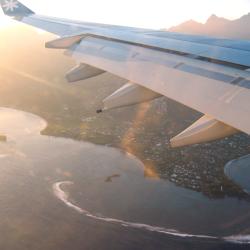
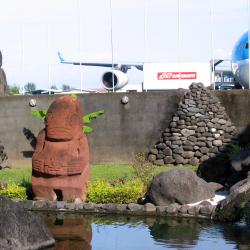
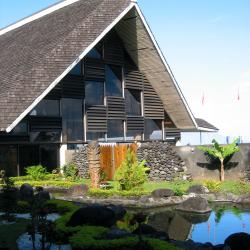
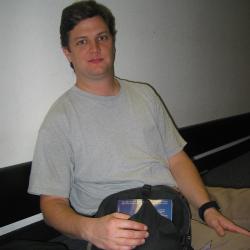 We arrived in Los Angeles from Little Rock via Houston with little incident. The Air Tahiti Nui flight boards in less than 1 1/2 hours, and the prospect of setting on plane for 8 hours, waiting, 3 hours, and then flying 6 hours more, only to sit in Auckland for 3 hours before flying on to Wellington, is, well, a little daunting. Though I’ve made flights of this duration quite a few times, I’m still a little amazed that it is possible to travel so far, so fast. I guess I should just find my seat, grab a drink, and reflect on how strange it is to be a 33,000 feet … while I’m at 33,000 feet.
We arrived in Los Angeles from Little Rock via Houston with little incident. The Air Tahiti Nui flight boards in less than 1 1/2 hours, and the prospect of setting on plane for 8 hours, waiting, 3 hours, and then flying 6 hours more, only to sit in Auckland for 3 hours before flying on to Wellington, is, well, a little daunting. Though I’ve made flights of this duration quite a few times, I’m still a little amazed that it is possible to travel so far, so fast. I guess I should just find my seat, grab a drink, and reflect on how strange it is to be a 33,000 feet … while I’m at 33,000 feet. The conference was more stimulating and interesting than I expected, and I was honored to be able to share the stage with University of Virginia’s
The conference was more stimulating and interesting than I expected, and I was honored to be able to share the stage with University of Virginia’s